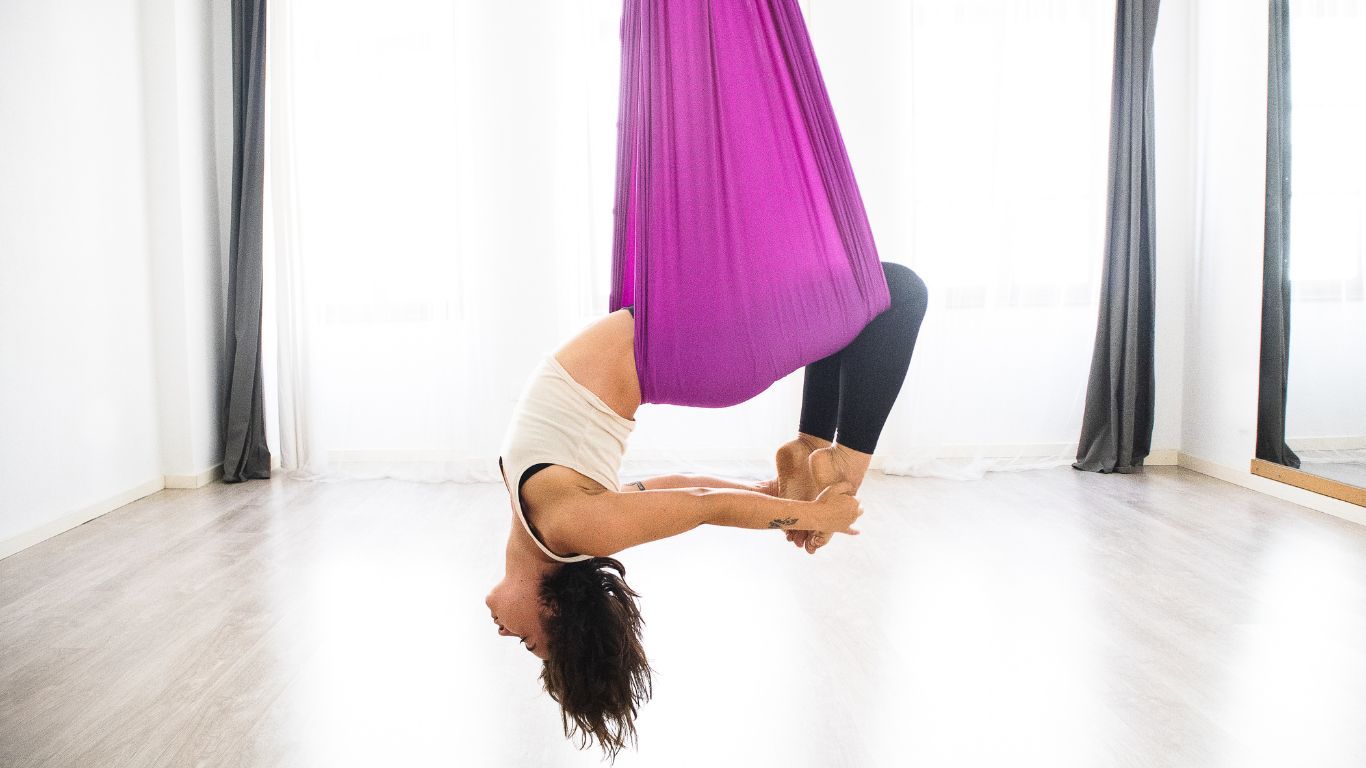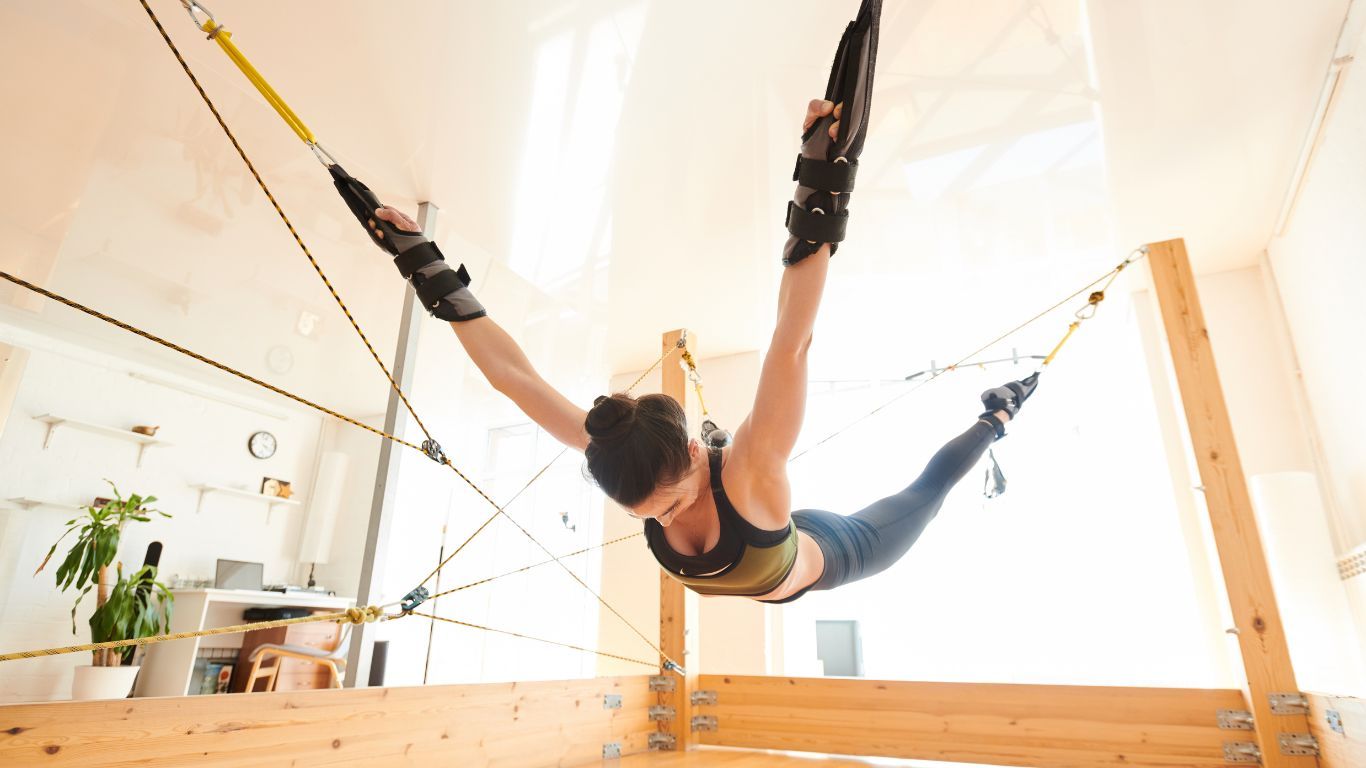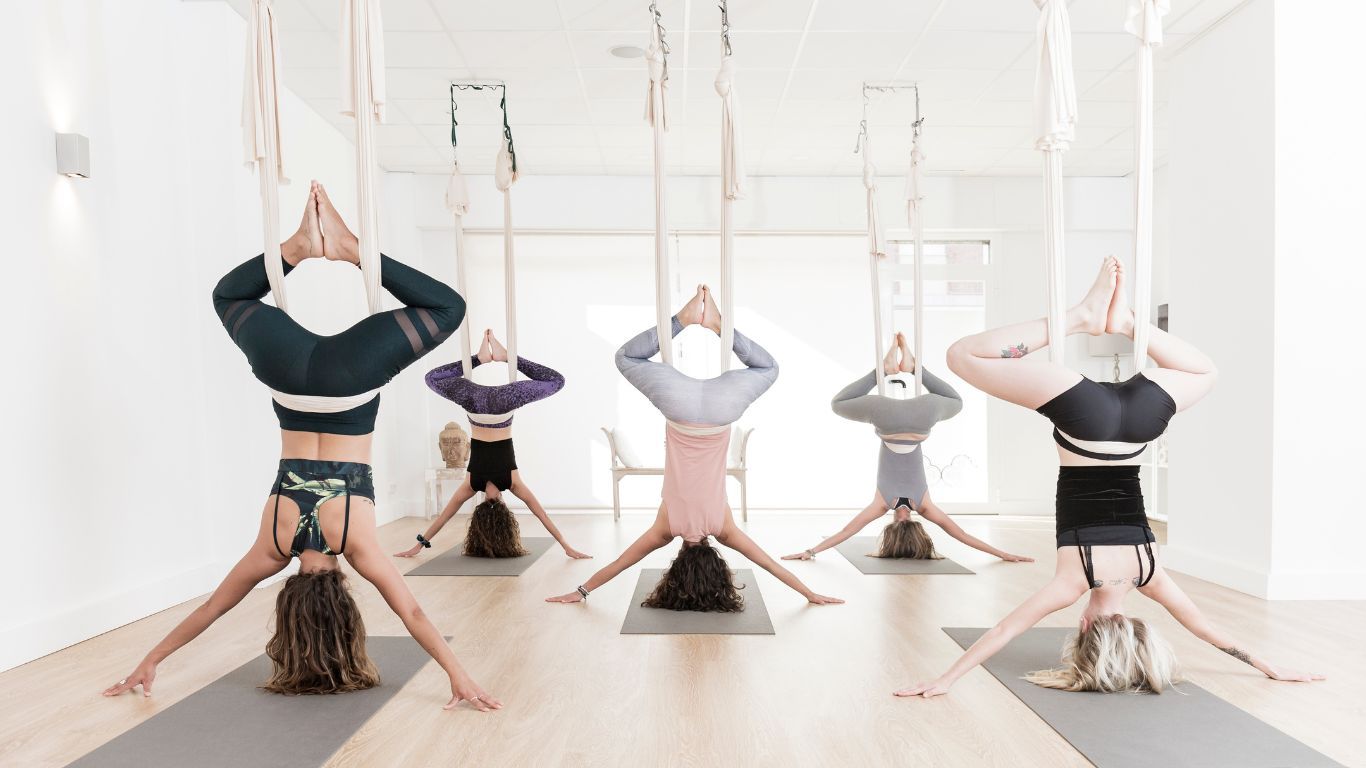
How much do you know about aerial yoga? In general, yoga is the holistic wellness exercise designed to support the mind and body. As a practice, yoga only continues to get more and more popular as time goes on, with various different types of yoga emerging.
Not only does practicing yoga promote relaxation, reduce stress, and enhance mindfulness, but it can also tone the body and support weight loss. Different forms of yoga have emerged to support people with varying goals. For instance, hot yoga is a common choice among people looking to detox and shed fat, while flow or power yoga is phenomenal for flexibility.
Aerial yoga is one of the most interesting new variations of yoga worth exploring for people who want to experiment with their acrobatic side, and unlock all kinds of unique therapeutic benefits.
What is Aerial Yoga? An Introduction
Aerial Yoga is a beautiful and engaging form of exercise which combines traditional yoga postures or “asanas” with aerial acrobatics. Practitioners and students use ropes, harnesses, and silk fabrics to ascend from the ground and hold poses while suspended in the air.
The practice of aerial yoga actually dates back much further than most people realize. Often, it’s connected to Iyenger yoga, which includes the use of props in creating and managing poses.
The carefully-chosen equipment selected for aerial yoga is designed to provide users with a sense of true weightlessness and freedom. You can allow yourself to be fully supported by the ropes as you move, or you can gradually remove more of your body from the ground, ascending higher into the ropes as you become more confident and skilled.
Anti-gravity yoga didn’t begin to generate significant traction until the late 1990s, when yogi studios around the world started implementing silk ropes and harnesses into classes to assist those with limited motion and joint discomfort.
More than just an instagrammable activity, aerial yoga improves flexibility, while removing pressure from certain areas of the body, to give you a greater range of motion. A study found 16 women who took three 50-minute classes each week lost an average of 2 and a half pounds in 6 weeks. They were also able to increase their VO2 max (the amount of oxygen the body can use in exercise) by 11%.

What to Expect from an Anti-Gravity Yoga Class
Since this particular type of yoga requires the use of specialist equipment, it’s something best practiced in the studio of a professional teacher. Beginners in particular should consider seeking out local classes to get them started, as this will ensure you know how to use your harness or sling correctly, while keeping risks to a minimum.
In an aerial yoga class, you’re likely to spend some time getting to know how to trust your body and the sling in different positions. Some of the most common asanas or “poses” in aerial yoga include:
· The inverted star: The Supta Konasana pose, or inverted star actually places your body upside down, so your head is pointed towards the floor and your legs are stretched out above you. This is an excellent way to boost circulation and stretch out the spine.
· Half pigeon: The half pigeon pose, or “Ardha Kapotasana” is great for beginners. One bent leg is placed on the ground, while another is stretched up and outwards with the sling, helping to open up your leg muscles and expand your hips.
· Anti-gravity warrior: A common pose in yoga adapted for the aerial arts, the anti-gravity warrior places both of your feet in the sling, stretched in a lunging position. You’ll stretch your arms out either side of you, creating balance, and tensing your core muscles.
· Superman pose: Suitable for either partial or full suspension, the superman pose stretches you out in a laid position, with both of your arms reaching forward. This helps to extend the muscles and joints, removing pressure from around the body.
· Tree pose: Another common asana in the yoga world, the “Vrkasana” or tree pose supports your body fully in the sling With one leg bent upwards, and a foot resting on your other thigh. You can stretch your arms up, or place them palms together in front of you.

The Benefits of Aerial Yoga
Aerial yoga isn’t just lying in a hammock and moving your body into different shapes, it’s identified as a moderate-intensity exercise which pushes practitioners to listen to their body, exert muscle strength, and control their breathing.
Experts believe hanging fully suspended from ropes, or using silk to elevate certain parts of your body creates greater tradition, and allows you to move more intuitively than you can on the ground. Some people even use aerial yoga as a way of enhancing balance.
The most significant benefits connected to aerial yoga include:
1. Better Flexibility and Stability
Aerial yoga allows users to experiment with their motion and the flow of movement without the threat of falling to the ground. When you’re suspended and supported by ropes, you’re likely to be far more confident testing your balance and learning how to develop stability.
What’s more, this form of yoga involves moving and managing all of the muscles in the body, which can help to strengthen your posture, and give you more control. According to one study from 2019, aerial athletes are more likely to have enhanced flexibility, strength, and balance.
2. Pain Management and Joint Support
As mentioned above, one of the biggest benefits of aerial yoga, is it’s easy on the joints. You can distribute pressure as you like, paying attention to any discomfort you might feel along the way. Hanging upside down, inverting, and leveraging the support of a harness decompresses the joints.
It’s also a fantastic way to get your body moving freely after being sat in front of a desk for long periods of time at work – something which can weigh down and compress the spine.
3. Low Impact Exercise
Though some forms of anti-gravity yoga can be quite intense, beginners can start at any level, even if they have pre-existing joint conditions or discomfort. As a moderate-level exercise, aerial yoga can deliver a multitude of benefits, including reduced risk of depression, stroke and hypertension. However, it’s low-impact nature minimizes discomfort and recovery times.
Ideal for people who want to improve their strength levels, and enhance their physical fitness without making existing conditions worse, aerial yoga is something anyone can practice.
4. Enhanced Mental Health
Any form of exercise can be excellent for promoting good mental health, reducing stress and tension, while boosting confidence and self-esteem. Aerial yoga gives beginners more freedom to push their boundaries without the risk of injury, which can lead to faster learning and higher levels of satisfaction. What’s more, studies show this exercise is great for battling depression.
One study found significant improvements in both stress and depression levels when people practiced the aerial arts. Adding aerial yoga to your routine can be a phenomenal way to relax, unwind, and improve your mental wellness.
5. Improved Resilience
Anti-gravity yoga, similar to most forms of exercise, works on strengthening the muscles and core strength. It can also improve circulation, which is fantastic for digestion and mental health. Although studies into the long-term impact of aerial yoga on resilience are limited, there is some research to show this exercise can significantly reduce your risk of other ailments.
If you discover in your CircleDNA report, you’re at higher risk of certain conditions such as cardiovascular disease, this type of yoga could be the perfect choice. One study found practicing aerial activities regularly lowers pressure on the heart and improves cardiovascular fitness.
Tips for Aerial Yoga Beginners
In general, aerial yoga is a fantastic choice for people of all health and fitness levels, because it ensures you can access additional support when you need it most. However, like any new exercise, it may require some practice. While you won’t need any prior knowledge of yoga to get started, you will need to be willing to take things slow and listen to your teacher.
The following tips should keep you on the right track:
· Trust your ropes: Whether you’re using ropes, silk, or a full harness, it’s important to trust the sling responsible for keeping you in the air. If you’re constantly worried you’re going to fall, you won’t be able to focus on enjoying the experience and exploring the movement of your body. Rest assured the sling will be able to hold you.
· Wear the correct clothing: Aerial yoga requires practitioners to have a full range of motion, so it’s important to invest in the correct gear. Women will need a sports bra, as well as a flexible set of leggings or yoga points which aren’t restrictive. If you’re sensitive to materials rubbing against your skin, make sure your clothing covers every part the ropes or silk might touch while you work out.
· Stay light: While eating before some workouts can help to give your body more energy, it’s not always a good idea with aerial yoga. Moving around, inverting your body, and placing pressure on different parts of yourself, including the stomach, can cause nausea. Don’t eat a big meal, but have a light snack or some fruit if you’re hungry.
· Know your limitations: Relax and enjoy the experience as much as you can. While some poses might look intimidating at first, they’re often much easier than they appear. If you feel you can’t do something, or you’re uncomfortable in a pose, speak up and request assistance from your instructor. Listen to your body and modify when necessary.
· Start slow: Doing anything suspended in the air can feel a little unnatural for us as human beings. The good news is you can start as slow as you want, keeping one foot or hand on the ground at all times. Don’t feel as though you have to be fully suspended straight away, unless you’re happy doing this.
Should You Try Aerial Yoga?
Aerial yoga is a unique and fun way to exercise, without overwhelming your joints and muscles. You can enjoy a fantastic work out, leveraging all of the core parts of your body, and strengthening your respiratory and circulatory systems. At the same time, you don’t need any prior knowledge to get started. If you enjoy the idea of yoga with extra support, this could be the option for you.
As always, when starting a new exercise or activity, it’s a good idea to speak to your doctor if you have any concerns, such as high blood pressure or anxiety which might make certain positions more problematic for you.
Find Out the Optimal Workout Program For You, Based on Your Genetics
Your DNA can provide you with a lot of insight on your genetic strengths and weaknesses, and the best workout routine for you, based on your genetic makeup.Read your genetic fitness reports from CircleDNA to find out some important tips on the the optimal exercises for you, based on your DNA.






